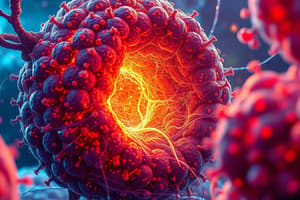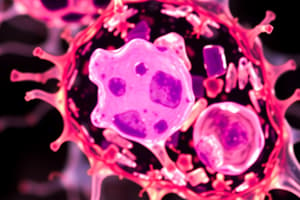Podcast
Questions and Answers
Which statement correctly describes prokaryotic cells?
Which statement correctly describes prokaryotic cells?
- Prokaryotic cells have membrane-bound organelles.
- Prokaryotic cells contain a true nucleus.
- Prokaryotic cells are generally larger than eukaryotic cells.
- Prokaryotic cells can only exist as unicellular organisms. (correct)
What is the primary chemical composition of bacterial cell walls?
What is the primary chemical composition of bacterial cell walls?
- Peptidoglycan (correct)
- Cellulose
- Pseudomurein
- Chitin
What is a characteristic of eukaryotic cells?
What is a characteristic of eukaryotic cells?
- They have no membrane-bound organelles.
- They are always smaller than prokaryotic cells.
- Their DNA is found within the cytoplasm.
- They generally evolved from prokaryotic cells. (correct)
Which of the following is NOT a shape associated with bacterial cells?
Which of the following is NOT a shape associated with bacterial cells?
Which term correctly describes the process by which cells arise from pre-existing cells?
Which term correctly describes the process by which cells arise from pre-existing cells?
What is the size range of eukaryotic cells compared to prokaryotic cells?
What is the size range of eukaryotic cells compared to prokaryotic cells?
Which statement about the antibiotic action on bacteria is accurate?
Which statement about the antibiotic action on bacteria is accurate?
Which characteristic is shared by both prokaryotic and eukaryotic cells?
Which characteristic is shared by both prokaryotic and eukaryotic cells?
What is the primary function of the electron gun in an electron microscope?
What is the primary function of the electron gun in an electron microscope?
What is the main difference in the final images produced by TEM and SEM?
What is the main difference in the final images produced by TEM and SEM?
What treatment is performed on a specimen before using a transmission electron microscope?
What treatment is performed on a specimen before using a transmission electron microscope?
Which statement accurately describes the use of a confocal microscope?
Which statement accurately describes the use of a confocal microscope?
What is required for the direct beam of electrons in an electron microscope to function properly?
What is required for the direct beam of electrons in an electron microscope to function properly?
During the preparation of a specimen for both TEM and SEM, what step is common?
During the preparation of a specimen for both TEM and SEM, what step is common?
Which device is used in a light microscope to control the brightness of the specimen's illumination?
Which device is used in a light microscope to control the brightness of the specimen's illumination?
What feature distinguishes an electron microscope from a light microscope in terms of radiation type?
What feature distinguishes an electron microscope from a light microscope in terms of radiation type?
What is the primary function of chloroplasts in plant cells?
What is the primary function of chloroplasts in plant cells?
Which organelle is known for producing and assembling ribosomes?
Which organelle is known for producing and assembling ribosomes?
What is a significant characteristic of mitochondria?
What is a significant characteristic of mitochondria?
Which structure is responsible for providing structural support in plant cells?
Which structure is responsible for providing structural support in plant cells?
What role does the Golgi apparatus play in the cell?
What role does the Golgi apparatus play in the cell?
In which type of cells would you find lysosomes, and what is their primary function?
In which type of cells would you find lysosomes, and what is their primary function?
What is the main distinction between rough and smooth endoplasmic reticulum (ER)?
What is the main distinction between rough and smooth endoplasmic reticulum (ER)?
Which cell organelle is most important for energy transformation?
Which cell organelle is most important for energy transformation?
What distinguishes the cell membrane from the cell wall?
What distinguishes the cell membrane from the cell wall?
What is the primary role of the cytoskeleton in a cell?
What is the primary role of the cytoskeleton in a cell?
Which of the following statements about vacuoles is true?
Which of the following statements about vacuoles is true?
Which feature is indicative of the endosymbiotic theory?
Which feature is indicative of the endosymbiotic theory?
What is the function of pilli and flagella?
What is the function of pilli and flagella?
What is the role of the light microscope in cell biology?
What is the role of the light microscope in cell biology?
Study Notes
What are Cells?
- Cells serve as the fundamental unit of life and reproduction.
Cell Theory
- Composed entirely of cells or derived from them, including viruses.
- All cells arise from pre-existing cells.
- Cell discoveries are attributed to advanced microscopy technology.
Size of Cells
- Plant cells range between 20-100 micrometers (μm).
- Animal cells measure 5-20 μm.
- Bacteria cells are the smallest, measuring 0.1-5.0 μm.
Prokaryotic Cells
- Lack a nucleus and membrane-bound organelles; DNA resides in the cytoplasm.
- Generally smaller and more ancient than eukaryotic cells.
- Exist predominantly as unicellular organisms.
- Major groups include bacteria and archaea.
Cell Shapes
- Bacillus: Rod-shaped (example: Lactobacillus).
- Coccus: Spherical or round (example: Streptococcus).
- Spirillum: Curved or corkscrew shaped.
- Vibrio: Straight rods with a single rigid curve.
Cell Wall Composition and Antibiotics
- Stiff cell walls stem from proteins and acids.
- Bacterial cell walls typically contain peptidoglycan, while archaea use pseudomurein.
- Antibiotics can disrupt cell wall formation, leading to cell destruction.
Eukaryotic Cells
- Distinguished by a true nucleus containing genetic material (DNA/chromosomes).
- Encompass organelles, which are membrane-bound structures.
- Evolved from prokaryotic cells supporting the endosymbiotic theory, evidenced by mitochondria and chloroplasts having their own DNA.
Cell Organelles and Their Functions
- Chloroplasts: Convert light energy into chemical energy via photosynthesis (found in plants).
- Mitochondria: Conduct cellular respiration to produce ATP energy (found in both plant and animal cells).
- Cell Wall: Provides structural support, made from cellulose (found in plants and fungi).
- Cell Membrane: Regulates substance movement and acts as a barrier to the external environment (found in both).
- Cytoplasm: Jelly-like substance that suspends organelles (found in both).
- Cytoskeleton: Maintains organelle positions and cell shape (found in both).
- Centrioles: Assist in cell division by organizing chromosomes (found in both).
- Vacuole: Storage structures; larger and permanent in plant cells, small and temporary in animal cells.
- Nucleus: Stores genetic information necessary for cell function (found in both).
- Nucleolus: Produces and assembles ribosomes (found in both).
- Ribosomes: Synthesize proteins based on genetic information (found in both).
- Endoplasmic Reticulum (ER): Transports substances; has smooth (lipid production) and rough (protein processing) types (found in both).
- Golgi Body: Modifies, processes, and packages cellular products (found in both).
- Lysosomes: Digest waste and foreign materials using enzymes (found in animals).
- Pili and Flagella: Appendages aiding movement in prokaryotic cells and some fungi.
Microscopy Technologies
- Light Microscope: Utilizes visible light and lenses for magnification, crucial for developing cell understanding.
- Electron Microscope: Uses electron beams for high-resolution imaging; operates under vacuum conditions.
- Transmission Electron Microscope (TEM): Provides internal images by slicing specimens thinly.
- Scanning Electron Microscope (SEM): Scans surfaces to produce external images.
Advanced Microscopy
- Confocal Microscope: Employs focused lasers for high-quality imaging and creates 3D images through computer enhancement.
Comparing Microscopes
- Light microscopes use light for magnification, while electron microscopes use electrons for higher resolution imagery.
Studying That Suits You
Use AI to generate personalized quizzes and flashcards to suit your learning preferences.
Related Documents
Description
Explore the fundamental concepts of cells, their differentiation, and the cell theory in this quiz based on Biology Module 1. Understand the sizes of various cell types and the technological advances that allow us to study them effectively. Test your knowledge of what distinguishes different cells and their role as the building blocks of life.



